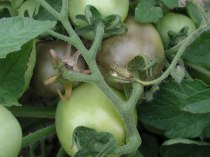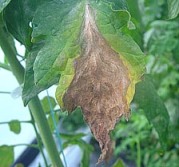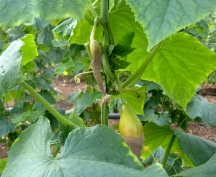Botrytis is a plant pathogenic fungus that is found virtually everywhere plants are grown and prefers damp, cool to mild weather. It grows quickly, can grow utilizing many different sources of nutrients, prevails easily in greenhouses, and attacks numerous plant types. The disease caused by Botrytis fungus is commonly called Botrytis blight or gray mold. There are several species of the fungus Botrytis which can cause blights; the most common is Botrytis cinerea.
Host Plants
Botrytis can infect many ornamental plants including: anemone, begonia, calendula, chrysanthemum, cyclamen, dahlia, dogwood, fuchsia, geranium, hawthorn, heather, hydrangea, marigold, pansy, periwinkle, peony, petunia, rose, snapdragon, sunflower, sweet pea, tulip, violet, zinnia.
Among vegetables and fruits Botrytis can infect asparagus, bean, beet, carrot, celery, chicory, crucifers, cucurbits, eggplant, endive, grape, lettuce, onion, pepper, potato, raspberry, rhubarb, rutabaga, shallot, strawberry, tomato, turnip, and others.
Causes
Initial contamination is usually through fungal spores carried about in the wind which infects host plant through a point of damage such as insect damage, decaying plant tissue or pruning wounds. Botrytis overwinters on plants, in or on the soil, and as sclerotia (compact mass of hardened fungus containing food reserves with the capability to remain dormant until favorable growth conditions return).
Spores develop when conditions are optimal, and are moved around by wind or splashing water onto blossoms or young leaves, where they germinate and enter the plant. Spores require cool temperatures (45-60 deg. F) and high humidity (93% and above) to germinate. Green, healthy tissue is rarely penetrated by germinating spores, but they can enter through wounds on growing plants. Cuttings are particularly prone to infection.
The soil surface and the densest areas of plant canopy are likely places for Botrytis to be found. It usually develops on wilted flowers first, and then quickly spreads to other parts of the plant. Harvested fruits and vegetables in storage are also potential targets of the disease.
Symptoms and Damage
On flowering plants, the first symptoms you may see will be water-soaked spots on the leaves, flowers, or stems. These spots will quickly develop fuzzy gray or whitish growth. Infections often start as flower blights because older petals are more susceptible. Damage will soon spread to other flowers and parts of the stem, which then collapse as the flowers dry and turn brown.
On fruiting plants, a gray, tan, or whitish fluffy mold grows on berries and other fruit, which when disturbed, will emit of a puff of gray spores that scatter. Infected fruit will have water-soaked spots, which later appear light brown and crack as the fungus grows. On berries the entire fruit becomes water-soaked and rots.
Organic Control and Prevention of Botrytis Blight
1. Practice good sanitation: Strict sanitation is of utmost importance and cannot be overemphasized. Remove dead or dying tissue from the plants and from the soil surface as the fungus readily attacks them and produces tremendous quantities of airborne spores. All old blossoms and dead leaves should be removed, and all fallen leaves and plant debris in the garden and greenhouse should be carefully collected and burned or hauled away with the trash. Ideally, all diseased plants and plant parts should be removed and destroyed. Botrytis spores are always present, but they don’t germinate until exposed to cool and moist conditions, especially high humidity. Try and prevent these conditions from being prevalent for long.
2. Avoid overhead watering: Water on foliage and flowers from overhead watering, especially on cool, cloudy days, promotes the disease. Try keeping the plant parts above the surface dry. Soil surface irrigation and watering in the morning is recommended.
3. Properly space plants for maximum air circulation: The fungus thrives in areas that are cool and moist and in densely packed areas. Prune or stake the interior of dense plants to increase air movement. In greenhouses, ensure maximum air circulation by either increasing heat in the greenhouse or inculcating forced circulation and ventilation. Even lowering the humidity slightly can have a significant effect on Botrytis.
4. Avoid over-fertilization: Do not over-feed your plants, especially with nitrogen as tender growth is susceptible to fungus.
5. Avoid unnecessarily wounding plants: Wounds are possible entry sites for pathogens of all types including Botrytis, so avoid injuring plants in any way. Do not leave large stubs of tissue on stock plants when taking cuttings.
6. Store harvest immediately in proper conditions: Only blemish-free, flowers, fruits, vegetables and plant material should be stored in clean, cool and dry environment without moisture on the walls, ceilings or floor. The temperature should be as close to freezing as possible.
7. Preventative biological fungicide: Developed from naturally occurring bacteria, Streptomyces griseoviridis, Mycostop biological fungicide thrives in the root zone of plants. When applied as a drench or spray the dried spores and mycelium of the Streptomyces culture in Mycostop germinate and begin to grow on and around the plant roots. In doing so, they create a biological defense against root infecting pathogenic fungi which cause disease such as wilt and root rot. This is a preventative treatment, and must be used at the time of seeding or transplanting. Mycostop has been shown to promote the growth and yield of plants even in healthy crops.
8. Plant resistant cultivars: Whenever possible grow plant varieties that are known to be less susceptible to Botrytis.
9. Organic fungicides: Spray susceptible plants with an organic fungicide like Neem oil or Soap-Shield to keep fungal diseases and other pests at bay.




Leave a comment
Comments feed for this article